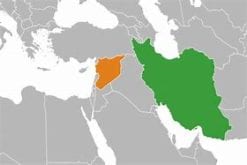RFL/RE – A top Iranian judiciary official has said antigovernment protest leaders should be handed the harshest possible sentences, while President Hassan Rohani suggested demonstrations were driven by opposition to his ultraconservative rivals in the ruling elite.

Rohani and Hamid Shahriari, deputy head of Iran’s judiciary, spoke on January 8 — nearly two weeks after the start of a series of protests that have shaken the country and attracted attention worldwide.
The ISNA news agency quoted Shahriari as saying that “surely those who organized and led the unrest against the establishment can expect the maximum penalty.”
The death penalty is the most severe sentence imposed by courts in Iran, where it can be applied for a range of crimes including treason, murder, and drug trafficking.
Iran’s Islamic Revolutionary Guards Corps (IRGC), a powerful military branch created to protect the Islamic system established after the shah’s 1979 overthrow, has repeatedly described the antigovernment protests as acts of “sedition.”
Foreign Powers Blamed
State media outlets have claimed that the protest leaders were either members of the People’s Mujahedin of Iran, an exiled dissident group that backs the overthrow of the Islamic Republic, or monarchists.
Iran’s government also claims that the protests have been fomented by foreign powers including the United States, Israel, and Saudi Arabia.
At least 22 people have been killed and 1,700 arrested in the government’s crackdown against the protests that began on December 28.
At a special session of parliament on January 7, Iranian lawmakers discussed how to deal with dissenting demonstrators.
They said later that low-level protesters, particularly students, are to be released in waves while the leaders are to be punished.
State media reports suggest that hundreds of detainees, including many students and other young people, have been released since January 6 after signing a pledge not to “re-offend.”
Meanwhil Rohani, a relative moderate in a system in which Supreme Leader Ayatollah Ali Khamenei holds ultimate power, said on January 8 that the Iranian people “have a legitimate right to demand that we see and hear them and look into their demands.”
Rohani suggested the real targets of the protests have been the powerful conservative clerics who oppose his plans to expand individual liberties and promote better relations with Western countries.
“It would be a misrepresentation and also an insult to Iranian people to say they only had economic demands,” Rohani told the state-run Tasnim news agency. “People had economic, political, and social demands”
“We must simply accept the fact that the people have the last word,” Rohani said. “We [politicians] must accept that we are now sitting in a glass house.”

Iranian Foreign Minister Mohammad Javad Zarif speaks during the Tehran Security Conference on January 8.
In comments echoing Tehran’s claim that the intelligence services of foreign countries were behind the protests, Foreign Minister Mohammad Javad Zarif warned other countries not to foment insecurity in Iran.
Zarif told a security conference in Tehran on January 8 that “no country can create a secure environment for itself at the expense of creating insecurity among its neighbors.”
The official IRNA news agency quoted Zarif as saying that “such efforts” will only backfire.
The United States has rejected Iran’s claims that Washington was behind the protests, which have led to the deaths of 22 people and the arrest of more than 1,700 others.
IRAN LIVE BLOG: Antigovernment Protests Reportedly Continue
CIA chief Mike Pompeo denied on January 7 that his agency had any role in the protests, but predicted the unrest “is not behind us.”
President Donald Trump has praised the protesters and said that Washington would throw its support behind them at a suitable time.
“Such respect for the people of Iran as they try to take back their corrupt government,” Trump wrote on Twitter on January 3. “You will see great support from the United States at the appropriate time!”
In other tweets, he has described Iran as “failing at every level” and declared it is “TIME FOR CHANGE!”
EU Invites Zarif
On January 7, German Foreign Minister Sigmar Gabriel said the European Union would invite Zarif for talks about the antigovernment protests.
Gabriel told ZDF TV in Berlin that “together with the EU’s foreign policy chief [Federica Mogherini], we agreed to invite the Iranian foreign minister, if possible next week.”
“We very quickly affirmed that we support the freedom to demonstrate and that the state should support this,” Gabriel said.

German Foreign Minister Sigmar Gabriel (file photo)
The IRGC suggested on January 7 that the protests had been quashed, saying “Iran’s revolutionary people” and security forces had “broken down the chain” it claimed was created by the United States, Britain, Israel, Saudi Arabia, militants, and monarchists.
But RFE/RL has received credible reports that protests continued in at least nine cities across Iran on January 6, including Tehran, where social media footage showed gatherings despite a large police presence.
Reformists Deny Foreign Involvement
Meanwhile, a group of 16 prominent reformists living in Iran issued a statement rejecting the government’s claim that the protests were organized and orchestrated by foreign countries.
The signatories said, “Despite the fact the enemies of the country always try to take advantage of such events, we should know that any kind of foreign interference would not be possible without the existence of internal conditions.”

Iranian students clash with riot police during an antigovernment protest at Tehran University on December 30.
Access to the Telegram messaging app remained blocked on January 8 in Iran, despite claims from Iran’s FARS news agency on January 7 that the restrictions on Telegram had been “fully lifted.”
“The parliament is not in favor of keeping Telegram filtering in place, but it must pledge that it will not be used as a tool by the enemies of the Iranian people,” Behrouz Nemati, a spokesman for the parliament’s presiding board, said.
Almost a third of Iran’s 80 million people use Telegram as their main source of news and as a way of bypassing the highly restrictive state media.
 Shabtabnews In this dark night, I have lost my way – Arise from a corner, oh you the star of guidance.
Shabtabnews In this dark night, I have lost my way – Arise from a corner, oh you the star of guidance.


